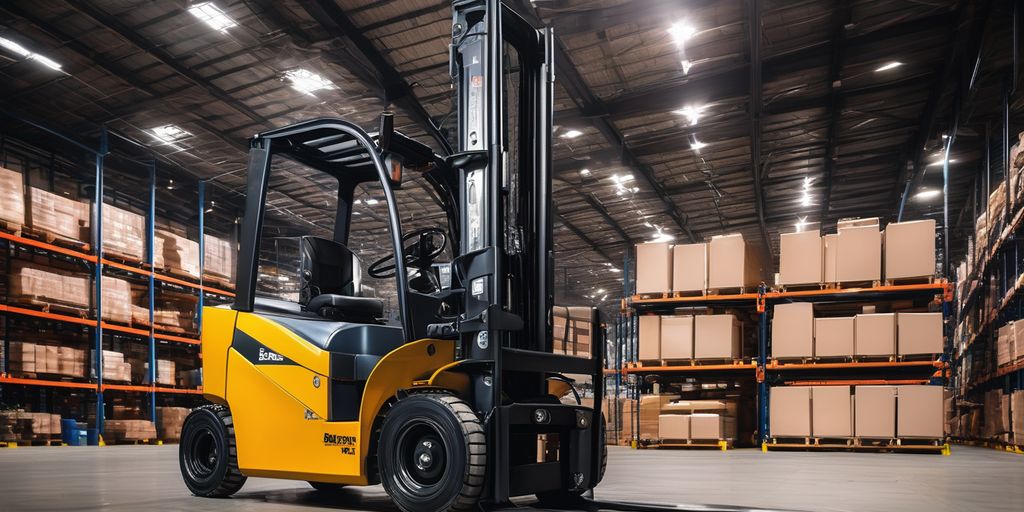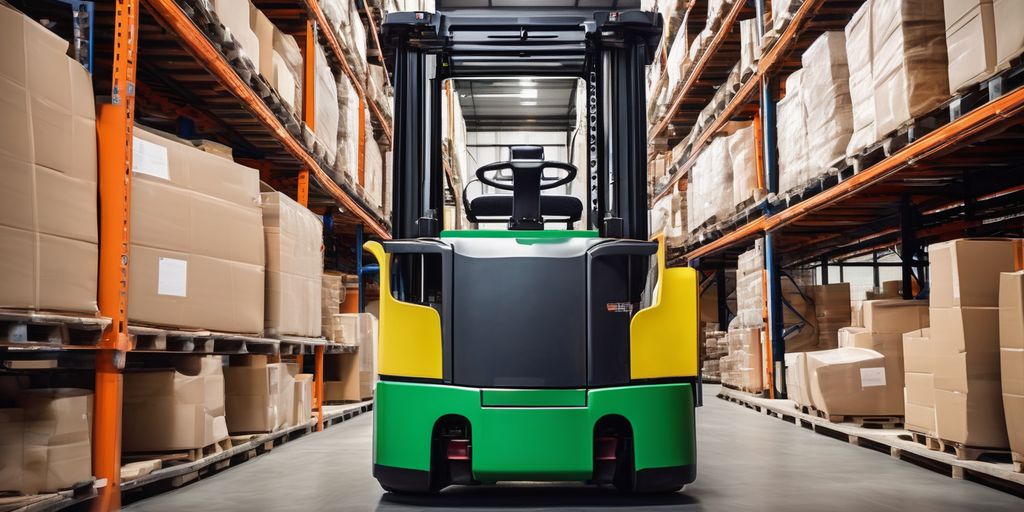Electric forklifts are changing the way businesses handle materials. These modern machines offer a mix of advanced technology, safety, and efficiency. Let's dive into the top features of the latest electric forklift models.
Key Takeaways
- Electric forklifts use advanced batteries like lithium-ion for longer life and quicker charging.
- Safety features, such as stability control and operator assistance, enhance workplace safety.
- These forklifts are designed to be energy-efficient, reducing overall operational costs.
- Ergonomic designs improve operator comfort and visibility, leading to better productivity.
- Electric forklifts contribute to a cleaner environment by producing zero emissions.
Advanced Battery Technologies

Lithium-Ion Batteries
Lithium-ion batteries are becoming the go-to choice for many electric forklifts. They offer longer run times and faster charging compared to traditional batteries. These batteries are also lighter, which helps improve the overall efficiency of the forklift. One of the key benefits is their ability to be charged at any time, similar to a cell phone, without the need for a full discharge cycle.
Lead-Acid Batteries
Lead-acid batteries have been around for a long time and are still used in many forklifts today. They are generally cheaper upfront but come with some drawbacks. These batteries are heavier and take longer to charge. They also require regular maintenance, such as watering and equalizing, to keep them in good working condition.
Battery Management Systems
Battery Management Systems (BMS) are crucial for maintaining the health and efficiency of modern forklift batteries. A good BMS can monitor the battery's state of charge, temperature, and overall health. This helps in extending the battery's lifespan and improving its performance. Innovations in BMS technology are making it easier to manage and maintain forklift batteries, ensuring they operate at peak efficiency.
Enhanced Safety Features
Operator Assistance Systems
Modern electric forklifts come equipped with advanced operator assistance systems. These systems include collision avoidance and object detection, which help reduce the cognitive load on operators. By providing additional support, these features enhance overall safety and efficiency in the workplace.
Stability Control
Stability control systems are crucial for preventing accidents. They ensure that the forklift remains stable, even when carrying heavy loads or navigating uneven surfaces. This feature is particularly important for maintaining balance and preventing tip-overs, which can be dangerous for operators and nearby workers.
Emergency Features
Emergency features, such as seat belt locks and emergency stop buttons, are designed to protect operators in critical situations. For instance, a seat belt lock can detect when the seat belt is unfastened and restrict travel, ensuring that the operator remains secure. Additionally, emergency stop buttons allow for immediate shutdown of the forklift in case of an emergency, providing an extra layer of safety.
Performance and Efficiency

Load Capacity
Electric forklifts come with varying load capacities to suit different needs. For instance, models like the ERP-VL series offer load capacities ranging from 4,500 to 7,000 pounds. This range ensures that businesses can select a forklift that matches their specific requirements, whether for light or heavy-duty tasks.
Energy Consumption
One of the standout features of modern electric forklifts is their eco-efficient technology. These forklifts are designed to consume less energy while delivering high performance. For example, the latest motors provide precise acceleration control and generate higher torque at low speeds, making them both powerful and energy-efficient.
Operational Range
The operational range of electric forklifts has significantly improved over the years. With advancements in battery technology, these forklifts can now operate for longer periods on a single charge. This is particularly beneficial for businesses that require continuous operation without frequent recharging.
The evolution of forklift technology has led to machines that are not only more powerful but also more efficient, making them a valuable asset in any warehouse or industrial setting.
Ergonomic Design
Operator Comfort
Ergonomic forklift design prioritizes operator comfort and safety, reducing strain and fatigue. Features like adjustable seats, controls, and cabin layouts optimize posture and visibility, minimizing musculoskeletal issues. Ergonomic design in OEM-integrated vehicles boosts productivity by enabling operators to work efficiently throughout shifts in a comfortable, strain-free environment.
Control Layout
Innovative control interfaces, such as mini levers and joysticks, are positioned closer to the operator for easier reach and reduced strain. These controls are designed to match the natural resting position of the human hand, enhancing comfort and efficiency.
Visibility Enhancements
Forklift cabins are designed with operator comfort in mind, featuring adjustable seats, steering columns, and control consoles. The cabin layout is optimized for easy access and visibility, reducing strain and fatigue.
Environmental Benefits
Zero Emissions
Electric forklifts produce zero direct emissions, making them a much more environmentally friendly option compared to traditional diesel or gas-powered models. They do not contribute to air pollution or climate change and are ideal for indoor use where air quality is crucial. This eco-friendly choice not only promotes sustainability but also leads to significant operational savings, making electric forklifts the future of material handling.
Noise Reduction
Electric forklifts are quieter than their traditional counterparts, reducing noise pollution in the workplace. This quieter operation not only creates a more pleasant work environment but also enhances community engagement and safety. The reduced noise levels contribute to a more focused and less stressful atmosphere for operators and other workers.
Energy Efficiency
Advancements in battery technology, particularly the use of Lithium-ion batteries, have made electric forklifts more efficient and practical. These batteries have a longer lifespan compared to traditional lead-acid batteries, requiring less frequent replacement. They also charge more quickly and efficiently, resulting in reduced downtime. Additionally, features like regenerative braking systems recapture energy during braking, further increasing the efficiency of electric forklifts.
Integration with Automation
Autonomous Operation
Autonomous forklifts are revolutionizing the logistics industry. These machines can navigate warehouses without human help, thanks to advanced sensors and navigation systems. This technology significantly boosts efficiency by reducing downtime and increasing the speed of operations. For example, Automated Guided Vehicles (AGVs) are a type of autonomous mobile robot that can handle repetitive tasks with high accuracy.
Fleet Management Systems
Fleet management systems allow companies to monitor and control their forklift fleets in real-time. This integration enables data-driven decision-making, improving overall logistics operations. Key benefits include:
- Real-time tracking of forklift locations
- Maintenance scheduling and alerts
- Performance analytics and reporting
Remote Monitoring
Remote monitoring systems provide a way to oversee forklift operations from a distance. This feature is particularly useful for large warehouses and distribution centers. It allows managers to ensure that everything is running smoothly without being physically present. Remote monitoring can lead to quicker response times in case of issues, enhancing overall operational efficiency.
Integrating automation with forklifts not only improves efficiency but also enhances safety and reliability in warehouse operations.
Versatility in Applications

Electric forklifts are known for their versatility in various applications, making them a popular choice across different industries. Let's explore how these machines excel in different environments and tasks.
Cost Considerations
Initial Investment
When buying a new electric forklift, the initial investment can be significant. New models come with advanced technology and warranties, which can justify the higher price. However, it's important to weigh this against your budget and operational needs.
Maintenance Costs
On the other hand, the maintenance cost for a new forklift is approximately $5,000 per year due to less wear and tear. New forklifts often require less frequent repairs, which can save money in the long run.
Long-Term Savings
While the upfront cost is higher, electric forklifts offer long-term savings. They have lower fuel costs and fewer parts that need replacing. Over time, these savings can offset the initial investment, making them a cost-effective choice.
Considering lifetime costs, including maintenance and fuel, rather than just the initial purchase price, is crucial when choosing the right forklift for your needs.
Conclusion
In conclusion, the latest electric forklift models bring a host of benefits to the table. They are not only eco-friendly but also cost-effective in the long run. With advancements in battery technology and features like regenerative braking, these forklifts are becoming more efficient and practical for various applications. Whether you need a forklift for indoor or outdoor use, there's likely an electric model that fits your needs. As businesses continue to seek sustainable and efficient solutions, electric forklifts stand out as a smart choice for the future.
Frequently Asked Questions
What are the benefits of electric forklifts compared to gas or diesel forklifts?
Electric forklifts have many advantages, like lower running costs, no emissions, less upkeep, better comfort for the driver, and quieter operation.
Can electric forklifts be used outside?
Yes, electric forklifts can work outside, but they are usually better for indoor use. Some models are made for outdoor use with special tires and weather protection.
Are electric forklifts as strong as gas or diesel forklifts?
Electric forklifts can be just as powerful as gas or diesel ones. There are high-capacity electric models for heavy jobs.
Do electric forklifts cost more to buy than gas or diesel ones?
Electric forklifts often cost more upfront, but they save money in the long run because they are cheaper to run and maintain.
Can electric forklifts work in cold places?
Yes, electric forklifts can work in cold areas, but very cold weather can affect the battery. Some models have special features for cold storage.
What kind of upkeep do electric forklifts need?
You need to check and take care of the battery, look at the tires and brakes, and make sure you charge them correctly. Follow the maker’s advice for maintenance.




Leave a comment
This site is protected by hCaptcha and the hCaptcha Privacy Policy and Terms of Service apply.